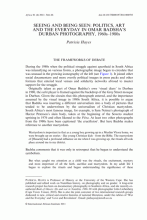A review of Omar Badsha’s ‘Seedtime Retrospective’ at Museum Africa, Johannesburg
Better... read more

There is an assumption that the photographic iconography of the South African struggle against apartheid is universally known and familiar. It is however dominated by certain tropes and categories that obscure the many complexities and nuances of its origins, its practitioners and its effects. This article focuses on one photographer, Omar Badsha, and explores his own narrations about city and family life in the Indian Ocean port city of Durban, and the artistic and political trajectories in which he was embedded that gave rise to his own photographic work and the organization of other photographers into the collective known as Afrapix. Badsha grew up in ‘the imperial ghetto’ of Grey Street in Durban within a rich legacy of radical political and cultural debate, becoming an artist and later a trade union organizer. It is the imperatives of the latter work that pushed him into photography as a medium of literacy. Many of his own photographs started as a personal visual diary when he re-explored the spaces of his childhood as an adult, and in the process became increasingly sensitized to the parallels between political and religious ritual. In particular he was fascinated by the dynamics between the leaders and the led, and the techniques and theatricalities of the different genres of mobilization. His work and the multiple forces and influences at play suggest that there were (and are) plural and competing aesthetic regimes during (and after) apartheid that are little recognized, mostly due to a deeply entrenched (and ongoing) separation between the domains of aesthetics and politics in South Africa and elsewhere outside the African continent.